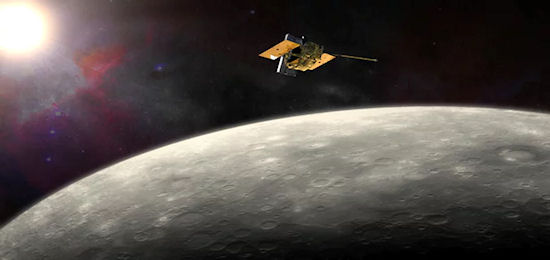Mercury is, next to Pluto, the second smallest planet in our solar system and the one closest to the sun. Due to its proximity to the sun it has the smallest “year” (time required for a full orbit around the sun), equal to 0,24 of an earth year.
One of the interesting facts about Mercury is that in its equator areas and during the “day” temperature rises up to 800801 degrees F, while in other places it drops down to -279 degrees F.
Mercury’s surface resembles that of the Moon, with vast flat areas, rocky cliffs and large craters. It is believed that the inner part of the planet is mainly consisted of iron and metals. The existence of a strong magnetic field around the planet indicates the possibility of liquid iron in its core.
The planet has no atmosphere, but is surrounded by thin layers of gases (mainly helium, hydrogen and sodium). The lack of oxygen indicates that the planet can not support life forms.
Missions to mercury
The first, and so far only, mission to Mercury was Mariner 10 (February-March 1974). The unmanned vehicle orbited the planet and took pictures of portions of its surface.
Today, NASA is preparing a new mission named MESSENGER,(MErcury Surface, Space ENvironment, GEochemistry, and Ranging), in order to acquire more information about the planet and areas of the inner solar system.
The mission’s main objectives are:
- Evaluation and explanation of the planet’s density
- Composition and recording of the surface
- eological history
- The exact force and origin of the planet’s magnetic field.
- The exact atmosphere composition
- Determining the nature of the mysterious polar caps (Radar imagery acquired in 1991 showed that deep craters at the poles remain in perpetual shadow, where temperatures remain hundreds of degrees below zero. Additional data revealed that the craters are highly reflective at certain wavelengths, indicating the presence of water ice.)
The Messenger is scheduled for launch on March 2004 and is expected to reach its objective one month later.




